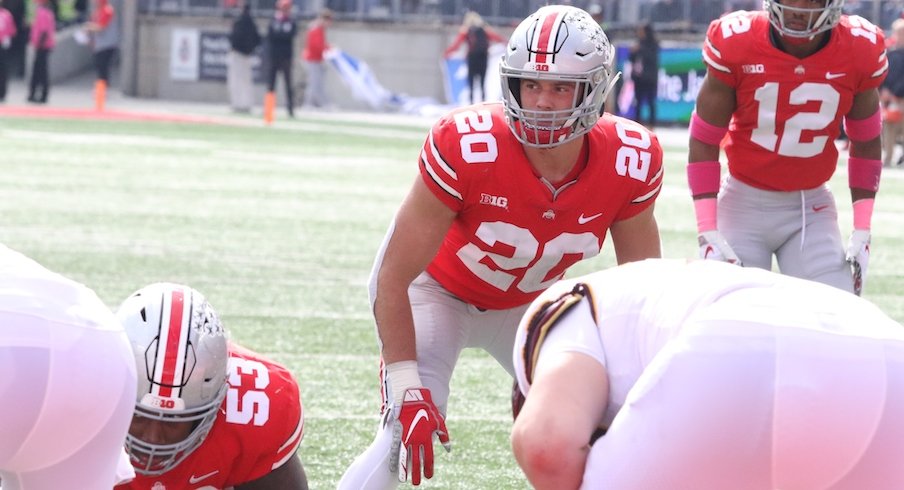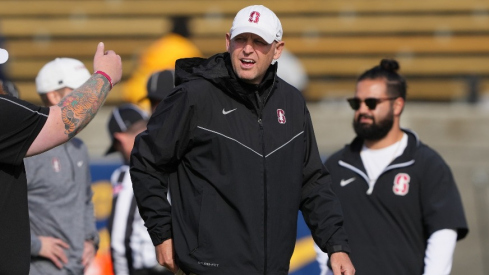Ohio State’s defense has struggled this season, and recently, one of the most prevalent theories of why has been that the Buckeyes play their linebackers too close to the line of scrimmage.
Coming off of a 49-20 loss at Purdue in which the Buckeyes gave up 539 yards to the Boilermakers, several former Ohio State linebackers have criticized that element of the defensive scheme, including James Laurinaitis.
“It’s impossible to make plays as a linebacker and react when you’re up at the heel-step of the defensive line,” Laurinaitis said earlier this week on ‘The Audible’ podcast. “You don’t get to see the whole field, you don’t get to recognize the setup of what is the offense telling me … when you’re up there along the line of scrimmage, you don’t have time to react on anything, you’re just lining up there and you’re easy for the line to grab you.”
Fellow former Ohio State linebacker Joshua Perry has also questioned the Buckeyes’ use of that alignment.
“Everybody’s taking advantage of the scheme,” Perry said on this week’s Eleven Warriors Radio Hour. “You’ve got guys lined up at the line of scrimmage … and what that does is it flattens out your defense, and it gives a guy a chance to have a 12-yard run at your safeties if the linebackers can’t make a play. So that right there is terrible.”
Purdue coach Jeff Brohm said on this week’s Big Ten teleconference that the Boilermakers took notice of Ohio State’s strategy of walking the linebackers up to the line of scrimmage, and they took advantage.
“I thought their linebackers were good players, but they were up at the line of scrimmage quite a bit,” Brohm said. “If you could get past that first level, there was a bigger level between them and the safeties because they play up so far.”
Problematically for the Buckeyes, opponents have been getting past that first level and making big plays against them all year.
In the Buckeyes’ third game of the season against TCU, that scheme was partially to blame for a 93-yard touchdown run by Darius Anderson, at that point the longest play ever allowed by an Ohio State defense. With Baron Browning up at the line of scrimmage and Ohio State in a nickel defense, the Horned Frogs only had to block one linebacker – Malik Harrison – and they did, leaving Anderson with one just one man to beat – safety Isaiah Pryor – on his long stroll to the end zone, which can you see in the following video.
Two weeks later, Penn State’s K.J. Hamler took advantage for a 93-yard touchdown of his own. With Harrison and Pete Werner both up the line of scrimmage, Hamler was left with just one man to beat – again, Pryor – after beating Shaun Wade on a slant route over the middle, and he too was successful.
Indiana took advantage on its opening possession against Ohio State. With Tuf Borland and Werner up at the line of scrimmage and Malik Harrison playing just a three yards back, the Hoosiers were able to catch them out of position and spring a hole up the middle for Stevie Scott to run for a 45-yard gain.
Purdue took advantage on multiple occasions on Saturday.
With Harrison and Werner at the line of scrimmage, D.J. Knox ran right up the middle between them, leaving him with just Jordan Fuller to beat, and he made Fuller miss en route to a 40-yard touchdown.

One drive later, Borland was up at the line of scrimmage, leaving the Boilermakers with just one linebacker in Werner to block over the middle against the Buckeyes’ nickel defense, and they did to spring Knox again for a 42-yard touchdown.
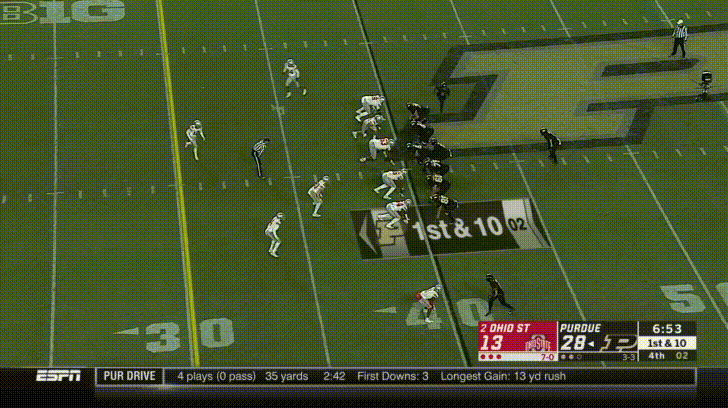
The scheme isn’t the only reason why Ohio State given up those big plays. The players at the line of scrimmage could certainly be stouter, and the players who aren’t on the line of scrimmage could certainly take better angles to the ball. But the schematic decision to play linebackers at the line of scrimmage has been a common thread in many of the big plays the Buckeyes have given up this year, and unless they make adjustments to that scheme, opponents will likely continue to exploit it for big plays.
Ohio State defensive coordinator Greg Schiano said this week that the Buckeyes actually have started walking their linebackers up to the line of scrimmage less frequently, in recognition of the success that opponents have had against that alignment.
“We actually moved away from that last week. So if you study the game, you watch the game last week, there was a few times in base defense – not even a few, probably a couple times in base defense – they were walked up,” Schiano said. “There’s a lot of positives that can come out of that if you can get good at it, the main one being getting double teams off your defensive line instantly. But it’s not something that our guys, we thought as we went through the season, we would get more and more comfortable with it – that hasn’t been the case. So Saturday, we really limited it and picked our spots to do it, the times that the play set up perfectly to do that. And we’ll probably continue to do that.”
At Schiano’s request, we did go back and study last week’s game – as well as the two games before it – to see how frequently the linebackers played up at the line of scrimmage. Those numbers, as compiled by Eleven Warriors data analyst Matt Gutridge, can be seen in the following tables:
| GAME | AT LEAST 1 LB AT LOS | NO LB AT LOS |
|---|---|---|
| PURDUE | 24 SNAPS (33.3%) | 48 SNAPS (66.7%) |
| MINNESOTA | 17 SNAPS (29.8%) | 40 SNAPS (70.2%) |
| INDIANA | 46 SNAPS (62.2%) | 28 SNAPS (37.8%) |
| AVERAGE PER GAME | 29 SNAPS (41.9%) | 32 (58.1%) |
Based on the raw numbers, the Buckeyes actually played their linebackers at the line of scrimmage more against Purdue than they did the previous week against Minnesota.
That was partially, though, because the Buckeyes played substantially more snaps in their nickel defense, in which they play linebackers up more frequently. Ohio State was in a nickel or dime package for 53 plays against Purdue, while it played just 10 snaps of nickel defense against Minnesota.
Still, Ohio State only played a linebacker or linebackers at the line of scrimmage on a third of its plays against the Boilermakers, and of those 24 snaps, only six came in the Buckeyes’ base 4-3 defense, with one in a goal-line package, while the other 17 came in nickel or dime packages. The Buckeyes only played two linebackers at the line of scrimmage for one play in their base defense.
Against Minnesota, the Buckeyes played at least one linebacker at the line of scrimmage on 11 plays in their base 4-3 defense. And one game earlier against Indiana, Ohio State played at least one linebacker at the line of scrimmage on 29 plays in their 4-3 defense, including 13 plays with two of its three linebackers at the line of scrimmage, and had linebackers up at the line of scrimmage for nearly twice as many snaps (46) than in the Purdue game.
So the Buckeyes have started playing their linebackers at their normal depth more often in their base defense, and Schiano says they will continue to do so. In later-down situations where the Buckeyes are looking to augment their pass-rush, however, they could still play their linebackers up at the line of scrimmage just as often.
“Third down and when you’re doing some exotic blitzes and things, we’re going to have them walked up,” Schiano said. “We always have. You get in the gaps and most teams do that.”
The Buckeyes have not played their linebackers at the line of scrimmage nearly as much on first and second downs as they have on third and fourth downs, as you can see in the following table:
| Game | 1st Down | 2nd Down | 3rd Down | 4th Down |
|---|---|---|---|---|
| PURDUE | 5/30 (16.7%) | 4/25 (16%) | 14/16 (87.5%) | 1/1 (100%) |
| MINNESOTA | 8/29 (27.6%) | 4/17 (23.5%) | 5/11 (45.5%) | 0/0 |
| INDIANA | 19/34 (55.9%) | 8/21 (38.1%) | 16/16 (100%) | 3/3 (100%) |
| TOTALS | 32/93 (34.4%) | 16/63 (25.4%) | 35/43 (81.4%) | 4/4 (100%) |
As you can see in the videos and GIFs above, several of the big plays allowed by the Buckeyes with their linebackers playing up at the line of scrimmage have come in third-down situations, so if they’re committed to continuing to play their linebackers that way in those situations, they’re going to be more susceptible to big plays than they would be otherwise.
But while the Buckeyes don’t want to keep giving up big plays, they also believe in being aggressive and making big plays of their own, and playing their linebackers up at the line of scrimmage has helped them do that at times this season, too. Perhaps most prominently, the Buckeyes had Harrison, Werner and Browning all crowded around the line of scrimmage for Chase Young’s game-sealing stop on 4th-and-5 at Penn State.
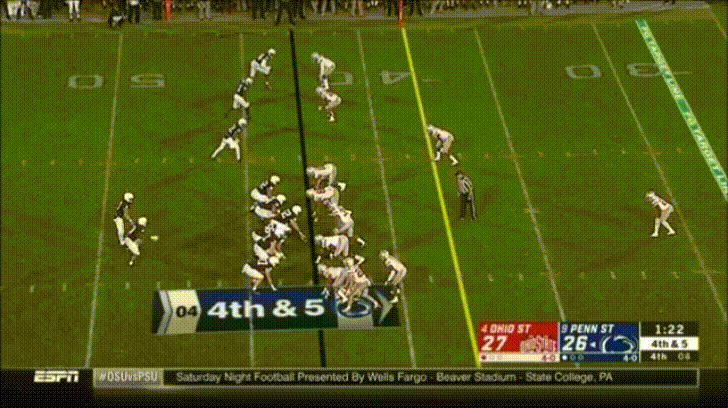
Another example, from another crucial play earlier in that game: Borland, lined up at the line of scrimmage, shooting a gap and forcing a fumble in Penn State’s backfield.
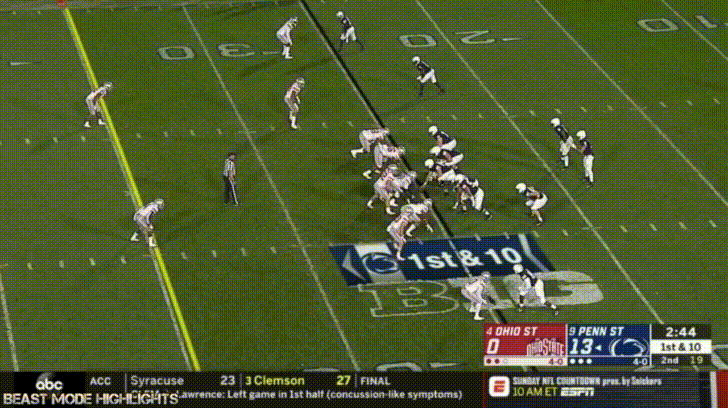
So as long as the Buckeyes believe that playing their linebackers up can give them more chances to make big plays like those, they’ll continue to use that strategy – though more selectively – in situations where they believe it can be advantageous.
“When you put a linebacker up in a gap, it takes double-teams off your defensive line, immediately. And with a talented defensive line, that gives you an opportunity to make plays in the backfield, and that’s occurred,” Schiano said. “We’ve backed away from it already. But that doesn’t mean it’s not going to show up either. It’ll be there sometimes. Just not at the level that it was earlier in the season.”
